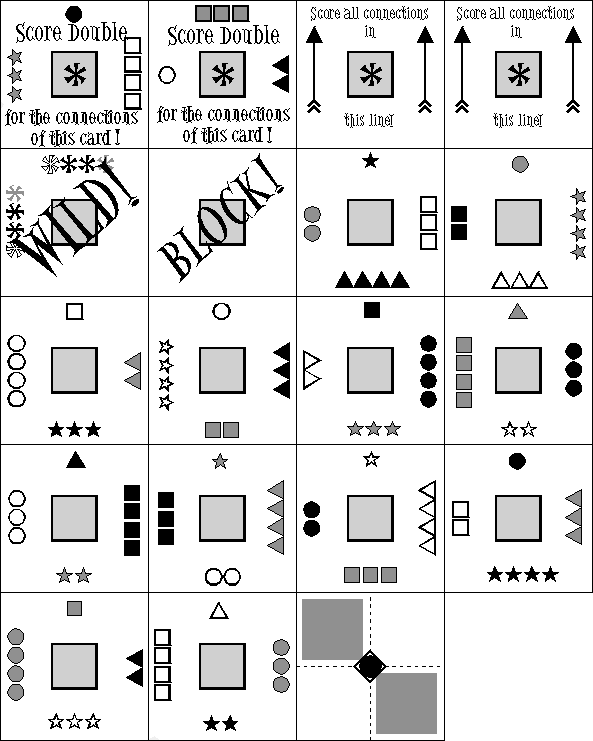
Copyright 2004 by Mike Petty
Synapse is a two-player game where players race to arrange their cards into scoring positions.
Like many real-time games, the play of the cards is fast and furious, then the scoring takes a little while as players figure out who actually won! Since only a complete understanding of scoring will allow a player to make good plays, however, it may be a little hard (while reading these rules) to understand when, where and maybe even why a player would place a cards into play. For now, suffice it to say that cards placed next to each other are potentially worth points if the icons on their adjacent sides match up in either shape, number or color. Sometimes a player will want to aim for matches worth maximum points. Other times he may want to form "connections" worth no points at all, in hopes of stopping his opponent from scoring. All the while a player has to keep a close eye on what his opponent is up to!
As far as the design goes, Synapse is my attempt at a real-time game that has no luck and no room for cheating during the fast play. I think it succeeds well on these two accounts. I'm curious what others may think of the game, though, so please send me your thoughts whether or not you get a chance to actually play the game!
In order to play, you'll have to print the graphic of cards below twice--one set for each player. Each set should be on different colored card stock or paper so players can easily distinguish their sets of cards when preparing for a round of play. You may want to save the graphic as a file and print it from a graphics program.

Each set of cards is made up of 12 standard cards and 6 special cards (two scoring lines, two double scoring cards, a wild and a block). There is also the "start card" printed on each set, but you only need one of these to play the game. The other one can be discarded.
To begin a round:
Imagine a 6x6 grid formed around the start square. It's best to leave some space between cards as you play. |
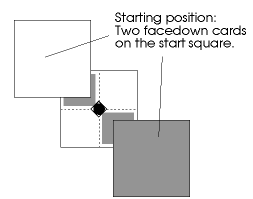
During play, a player can only use one hand to pick up and arrange cards. Cards may be picked up and placed into the 6x6 grid that is forming around the center card. When a card is placed into the grid, it must be:
Once a player places a card in the grid and removes his hand from it, the card may not be moved. Before he lets go of the card, though, he may rotate it, move it to a new location in the grid or even place it back with his other unplayed cards so he can pick up another one.
Since this game has no turns, players may occasionally try to place a card in the same open space at nearly the same time. Only the player whose card touches the space first gets to play there! Sometimes speed will be very important.
When placing cards, players are attempting to form high scoring connections between adjacent cards and to foil the plans of their opponent. The concept of connections and scoring is described below.
When one player places his last card into the grid, he calls "Stop!". The other player may not place any card on the table at this time. If he already had a card on the table and did not take his hand off the card, he may still rotate it the way he wants it, then he must stop playing.
Scoring may begin at this time.
To understand scoring, you must first understand the point value of "connections". This value is based on the icons on the edges of most cards. If you examine a few cards, you'll see these icons have three attributes. They are:
Using these attributes, there's one simple rule that allows you to calculate the value of any connection between two adjacent cards:
A connection between any two adjacent cards (no matter which player(s) the cards belong to) is worth a number of points equal to the number of matching attributes of the shapes at that connection.
For example, if three black triangles are placed adjacent to two black squares, the connection would be worth one point, since the color (black) is the only matching attribute at that connection. One white circle next to one white square would be two points, since the number (one) and color (white) match. A connection will, at most, be worth three points, when all three attributes match on adjacent cards. Most of the time the only way for a player to score a three-point connection is to place one of his cards next to his opponent's cards, since most combinations of shape, color and number occur only one time in each player's deck. Note too that a single card can have up to four connections--one at each edge that has icons on it.
Here is an example of how cards may look at the end of a round and how much the connections would be worth.
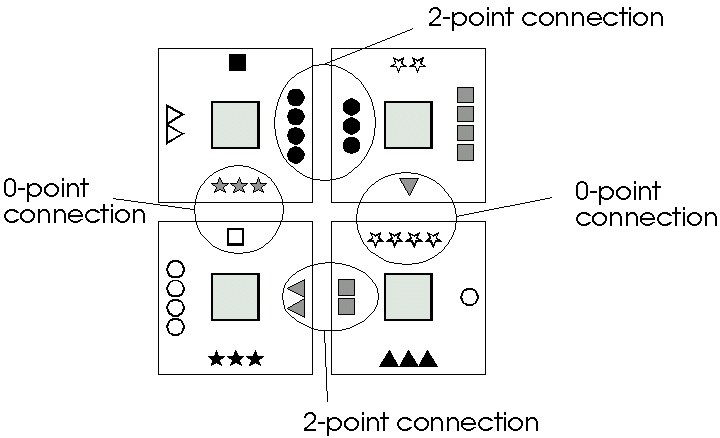
You'll find scoring goes quite quickly once you get used to counting the connections. Remember that a connection will range from 0 to 3 points at the most. A single card may have up to four connections, one at each edge. Some cards may not have four connections, however, since it may be placed at the edge of the grid, it may have no card next to it at the end of the round or you'll notice some cards have no icons on some or all of their edges.
Special cards that affect connections
The wild card matches the shapes exactly that are adjacent to the asterisks on the two edges of that card. The other two edges of the wild card do not form connections, since there are no shapes on them.
The block card does exactly that. It blocks connections on all four sides. As you might expect, it's most useful for putting an end to your opponent's big plans! A block card also stops a scoring line, which is described below.
Cards that allow a player to score points
It's important to note that the connections, by themselves, do not earn points for the players. Only the placement of the four scoring cards (the two "line" cards and the two "double" cards) actually earn a player points at the end of a round. Here is a description of how they are used.
A line card scores a player points from the connections on the cards that lie directly in line with the arrows on the line card. Here's an example.
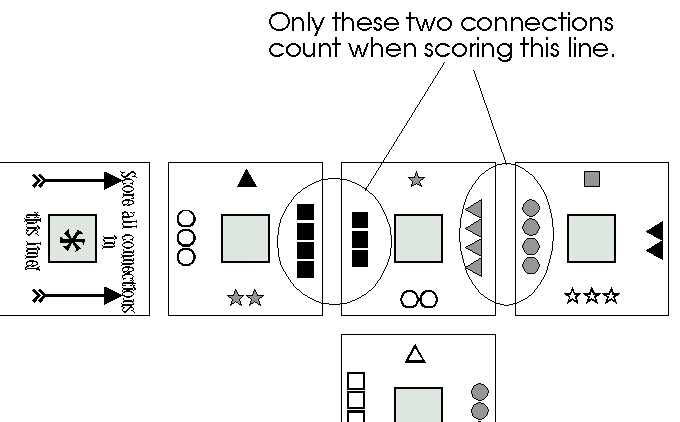
This line card would earn the player four points total. Two points come from the first connection in the line and two points come from the next connection. Note that the line card itself does not form a scoring connection (since it has no icons on it) and other connections (like the double white circle and single white triangle above) do not count because both cards forming the connection are not directly in the scoring line.
As noted above, a block card stops a line, so cards in a line that come after a block card would not be considered when totaling points for that line card.
The double cards will earn a player TWICE the number of points from connections formed with that card. Here's an example.
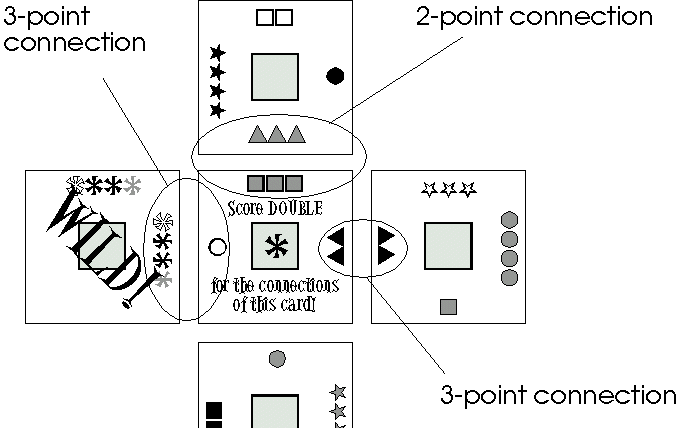
Here, the wild card automatically counts as a 3-point connection. The other two connections total 5 points, making 8 points from all connections of this double card. When doubled, this arrangement earns the player 16 points!
So, when the round ends, a player's points come from:
Scores can be tallied on a sheet of paper for each round. The player with the highest total score after three rounds is the winner. If there's a tie, play more rounds until one player gets the highest total score from all rounds played.
Return to Black & White Games Home
This page was last updated March 13, 2004.